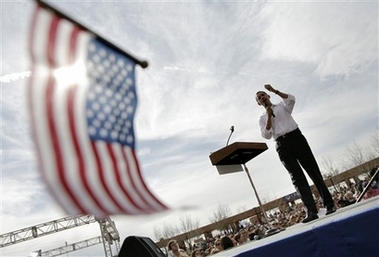 I am a big advocate of multichannel marketing. I don’t think you can force people to use the tools you want them to use to consumer your message, you need to talk to them with the tools they like or they just wont notice you.
I am a big advocate of multichannel marketing. I don’t think you can force people to use the tools you want them to use to consumer your message, you need to talk to them with the tools they like or they just wont notice you.
The Obama campaign was impossible to ignore; it was simply everywhere. They used traditional media such as radio, television and direct mail and they used them effectively because they understood their audiences and delivered crisp messages to them. Traditional media is the most effective route for targeting Baby Boomers and older Americans.
The fact that the Obama campaign could practically print money, made his ubiquitous multichannel marketing campaign possible. What candidate in history, after all, has could block off an entire half hour across the broadcast channels for his own commercial in the waning hours of the campaign? As it was, ABC’s waffling cost them Obama ad dollars but were it not for that, Obama would have had that time slot all to himself. Obama even bought a satellite channel for 24-hour Obama TV.
The campaign’s web site was not typical brochureware but instead ground zero for online organizers, where supporters could log in, find other supporters nearby, help the campaign identify likely voters, support volunteers in calling likely Obama-voters or canvasing. The site included all the tools necessary to enable supporters to successfully advocate for Obama online. The site was designed to encourage donations at every click.
Email updates were informal and each was focused on a single topic; they were short and to the point, they were frequent enough to stay top of mind, and usually included a link to a video with a campaign staffer talking directly to the subscriber.
The Obama campaign used YouTube for its video infrastructure. They set up a YouTube channel through which they communicated with YouTube users. But because YouTube videos can be pasted anywhere, they used their YouTube videos on their Web site, in their blog, on Facebook, and anywhere else they needed video. The campaign didn’t just upload television commercials to YouTube to extend their reach, but they had a prolific and hyper-responsive video production unit that created video that was intended to be used only online.
In addition to Facebook, MySpace and Twitter, the Obama campaign established a social networking presence at ethnic social networks like Black Planet, MiGente and AsianAve as well as Eons, Faithbase and Glee.
The campaign used Flickr to upload photographs from campaign rallies, speeches, and appearances. Not only does this engage people who were at those events, but the photos provide additional content to bloggers. Finally, and not insignificantly, the photos engaged the Flickr community itself, which is filled with very passionate photographers, amatuer and professional alike.
In addition to the Obama campaign’s brilliant use of text messaging and their mobile web site, the iPhone owners among their supporters could download an Obama app that encouraged people organize and spread the word.
In addition to search engine ads, the campaign bought online display ads in abundance. You could hardly read a political story on any major news Web site without seeing an accompanying Obama ad.
FInally, never one to pass on a highly targeted channel, the campaign also placed display ads in popular video games like Madden.
Video game ads are a perfect example of getting the message before an audience’s preferred medium. Adult Millennial men and young Gen X men are heavy gamers and, as a result, notoriously hard to reach. Video game ads were the perfect medium to reach these voters.
Next, I’ll address multichannel’s marketing cousin, microtargeting and how the Obama campaign extended this political marketing practice.
Read also:
The e-Strategy Academy covers all aspects of digital marketing including search optimization & marketing, email marketing, social media marketing, video marketing, mobile marketing & public relations.